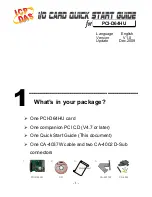
52
BIAC User Manual Brewing
1
2
3
4
5
6
For the last 10 minutes of the boil, the lid (with all valves removed and lid ports
left open) can be set in place (not clamped) to let steam sanitize the lid. During
this period the element power should be turned down (e.g., 40–70%) to reduce
the risk of boiling over. The process should be monitored during this entire period
to ensure boiling over does not occur, as the wort will foam more readily when
the lid is in place. The lid can also be sanitized with chemicals (it is best to always
have a spray bottle of dilute Star San on hand).
6. Cooling: About 30–60 minutes (depending on chilling water temperature and
flow rate)
Once boiling is complete, a chilling liquid (e.g., cold tap water) is run through the
fermenter jacket. It is important to keep the pressure of the chilling media in the
jacket below 5psi (7psi in the 4-in-1) or the vessel could be damaged (keep main
vessel body below 3psi in the 3-in-1 and 14.9psi in the 4-in-1). No restrictions
should be placed on the outflow of the jacket or pressure could build up, and
care should be taken that no restriction can impede flow (e.g., a hose kinking or
valve accidentally closing). For the larger systems, in addition to using the jacket
for chilling, some customers also use a separate plate chiller to reduce the chill
time and run a closed loop of hot wort out from the fermenter, through the plate
chiller and back into the fermenter. (Passing boiling wort through the lines, pump
and plate chiller for the last several minutes of boil will sanitize them; always
thoroughly clean the chiller immediately after use.) When using tap/tap water in
the jacket for chilling, a water pressure regulator should be installed before to the
jacket to help ensure pressure does not build up in the jacket. The lid should be
installed to keep out airborne contaminants, but a port should be kept open to air
during the cooling period, as a vacuum could form as the water cools, damaging
the fermenter (or a few psi of CO2 can be added into the fermenter to counteract
any loss of pressure as the wort cools and contracts). A pressure and vacuum
relief valve can be used to help protect the inside of the vessel. Don’t throttle
the flow rate of the chilling media too much as a good flow rate is necessary for
faster chilling (the greater the temperature difference between the water leaving
the jacket and the wort, the faster the chilling rate). If tap water is too warm,
it could be used for the majority of cooling (e.g., down to 30°C/90°F), and our
Water Chiller used for the rest. (The Chiller is a 120V water chiller that can control
fermentation temperatures but is not powerful enough for quickly removing the
massive amounts of heat contained in boiled wort.)
7. The Temperature Control Valve (TCV) is used (in conjunction with an ETC or
53
Tip: For best results, throughout the brew but especially after boil has ended,
always use good sanitary techniques. Keep a bottle of diluted Star San on
hand and liberally apply it to any object that may contact the wort/beer.
Summary of Contents for BIAC
Page 1: ......
Page 45: ...BIAC User Manual 44...
Page 56: ...Brewing 1 2 3 4 5 6 55 Notes...
Page 57: ......





































